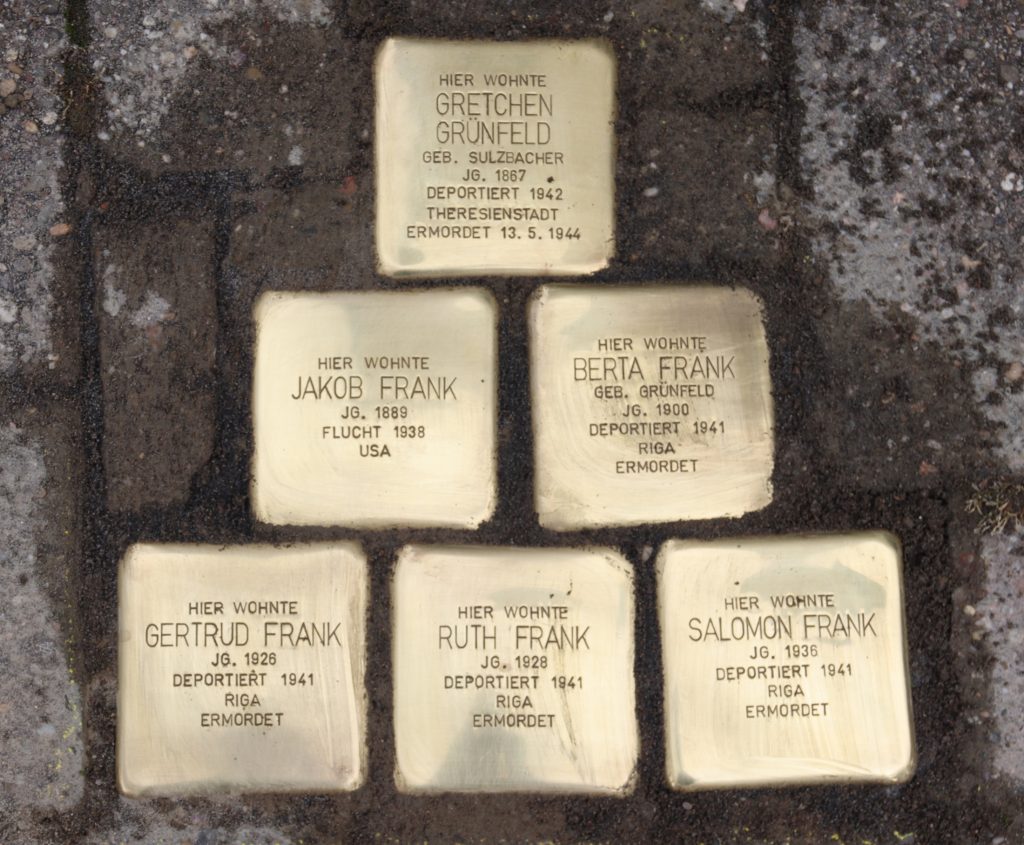
Locaction: Alte Frankenstraße 9 – Edelfingen
When Gretchen (Margarethe) Grünfeld, née Sulzbacher, was born in Tauberrettersheim, Bavaria, on March 30, 1867, civil equality for Jews was not yet complete. It was not until 1872 that Jews in Germany were legally equal in principle vis-à-vis society as a whole.
She was the second of four children of the merchant Simon Simche Sulzbacher (1828-1911) and Hanna Sulzbacher, née Grünfeld (ca. 1830-1917). She grew up together with two sisters, Babette Pessle (1865-1888) and Babette, called Betty (1875-1970 Haifa), another sibling probably died shortly after birth in 1869.
Even though the Jews were a minority in Tauberrettersheim, in 1867, the year of Gretchen’s birth, there were still 63 people (9 percent) of the 697 inhabitants of Jewish faith.
In which year Margarethe Anschel Meier married Adolf Grünfeld (1864-1927) is no longer known. However, she became a mother at least five times in relatively short intervals starting in 1895. After her sons Max Mordchai (1895-1928), Willy (1896-1941 Riga) and Joseph (1898-1942 Krasnystav Ghetto), she gave birth to daughter Berta (1900 – 1941 Riga) and son Leo (1901 – 1941 Litzmannstadt Ghetto).
The obituary of her husband, which appeared in the magazine “Der Israelit” on December 1, 1927, testifies to what her years as a wife and mother were like.
“Our small, unfortunately now almost extinct congregation, had again to mourn a bitter loss. On Sunday, November 6, Adolf Grünfeld – the memory of the righteous man is a blessing – was buried, the owner of the men’s clothing store S. Sulzbacher Nachfolger. It is only two years since we lost the unforgettable brother of the deceased, Josef Grünfeld. Now, with the two brothers, the last pillars of the local community have sunk into the grave. The funeral was an eloquent testimony to the popularity of Adolf Grünfeld in all circles of the population. Jews and non-Jews from the village and the surrounding area followed the bier, war associations and the volunteer fire department gave their last respects to their long-time member. The deceased was considered a model of an honest and industrious businessman. He tirelessly practiced the tailor’s trade often deep into the night. Those who watched him at work, with his little Jewish cap always on his head, will never forget this idyll of old Jewish craftsmanship. His workshop was located next to our quiet village synagogue – a symbol of the life of the deceased. It was dedicated to the Torah and to work. With ardent zeal Adolf Grünfeld – the memory of the righteous man is a blessing – held on to the traditional Judaism, he took care of the needs of the public and in the same sense he educated all his children. […]
More and more orphaned, our once thriving little community is left behind, a contribution to the sad chapter of the demise of rural communities. May his soul be bound in the covenant of life.”
Advertisement in the magazine “Der Israelit” of December 1, 1927: “Tauberrettersheim (Lower Franconia), November 20, 1927[1].
Only a good eight years later, there was no longer any sign of the tolerant mood in Tauberrettersheim. After Gretchen Grünfeld had already witnessed in 1935 that “there were attacks on Jewish houses, among others the house of the siblings Josef and Betty Gunzenhäuser was smeared with excrement several times”, things got even worse during the November pogrom in 1938. Now “SS and SA men entered the two Jewish houses in the village [and thus presumably Grechtchen Grünfeld’s house as well]: in one of the houses a window and a candlestick were destroyed, in the other all the furniture and household effects were smashed.”[1]
Exactly when the widow moved from Tauberrettersheim is unclear. On the one hand, there is a reference to the fact that in Tauberrettersheim “In the winter of 1939/40 […] two (non-Jewish) villagers [were] accused of having sold firewood to the merchant widow Gretel Grünfeld.”[1] On the other hand, she is already listed in Edelfingen – where her daughter Berta lived – in the May 1939 census. It is conceivable that the move occurred after the pogrom or in the course of the Edelfingen son-in-law’s escape to the USA in 1938.
What must have been going on in her mind during the few years she had left when one child after another was deported? After the deportation of her daughter Berta and grandchildren Gertrud, Ruth and Salomon in 1941, she probably lived alone in Edelfingen for quite some time. How and why a move to Würzburg took place in March 1942 is unknown. All that is known is that from that time on she lived in the Jewish old people’s home at Dürerstraße 20.
The home was forcibly dissolved in the same year. Doctors, nurses, employees, residents and the sick were deported. Among them was Gretchen Grünfeld. On23. Sept. 1942 she was deported to the Theresienstadt ghetto, where she perished on May 13, 1944.
1. http://www.alemannia-judaica.de/tauberrettersheim_synagoge.htm.
Laying date: 07.October 2021 Sponsorship: none Author: RH
